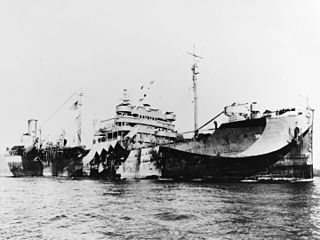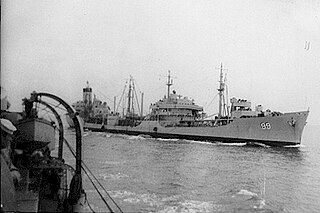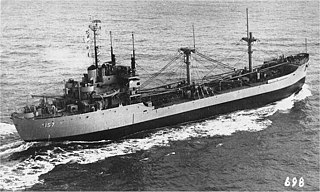
USS Laramie (AO-16) was a Kaweah-class fleet replenishment oiler in the United States Navy.

USS Mattole (AO‑17) was a Kaweah-class fleet replenishment oiler in the United States Navy.

USS Salinas (AO-19), a United States Navy Patoka-class replenishment oiler, was laid down for the United States Shipping Board (USSB) as Hudsonian (219592) on 10 April 1919 by the Newport News Shipbuilding and Dry Dock Co., Newport News, Virginia; launched on 5 May 1920; accepted by the USSB on 13 May 1920; transferred to the Navy on 29 October 1921; renamed Salinas and designated AO-19 on 3 November 1921; and commissioned at Mobile, Ala., on 16 December 1921.

USS Noxubee (AOG-56) was a Patapsco-class gasoline tanker acquired by the U.S. Navy for the task of transporting gasoline to warships in the fleet, and to remote Navy stations. She served in a commissioned status from 1945 to 1959, and 1965–1975. She was named for a river in Mississippi.

USS Ashland (LSD-1) was the lead ship of her class—the first dock landing ship of the United States Navy. She was the first Navy ship to be named for Ashland, the estate of Henry Clay, in Lexington, Kentucky.

The second USS Winooski (AO-38) was a Kennebec-class oiler in the United States Navy.

USS Tappahannock (AO-43) was a Kennebec-class oiler in the United States Navy that served during World War II, the Korean War, and the Vietnam War. She was sold for scrap in 1987.

USS Niobrara (AO-72) was a T3 Kennebec-class oiler constructed for the United States Navy during World War II. She was the only U.S. Navy ship named for the Niobrara River in Nebraska.

USS Elokomin (AO-55) was a Cimarron-class fleet oiler acquired by the U.S. Navy during World War II. She served her country primarily in the Atlantic Ocean, Mediterranean Sea, and the North Atlantic Ocean Theatre of Operations, and provided petroleum products where needed to combat ships.

USS Yukon (AF-9) was an Arctic-class stores ship in service with the United States Navy from 1921 to 1922 and from 1940 to 1946. She was scrapped in 1947.

USS Housatonic (AO-35) was a Chicopee-class oiler acquired by the United States Navy for use during World War II. She was the third ship of the U.S. Navy named for the Housatonic River in Massachusetts and Connecticut.

USS Aucilla (AO-56) was a Cimarron-class fleet oiler. She was constructed for the United States Navy during World War II and her assignment was to provide liquids, such as fuel or water, to ships in the forward battle areas. She survived this dangerous task and returned home post-war with five battle stars to her credit.

USS Chiwawa (AO-68) is a former T3-S-A1 Kennebec-class oiler constructed for the United States Navy during World War II. She was the only U.S. Navy ship named for the Chiwawa River in Washington.

USS Enoree (AO-69) was a Chiwawa-class oiler constructed for the United States Navy during World War II. She was the only U.S. Navy ship named for the Enoree River in South Carolina.

USS Canisteo (AO-99) was a Cimarron-class fleet oiler constructed for the United States Navy in the closing days of World War II. Commissioned too late for service in that conflict, she had a lengthy career in the Cold War that followed. She was the only U.S. Navy ship to bear the name Canisteo, after the Canisteo River in New York.

USS Alcona (AK-157) was an Alamosa-class cargo ship commissioned by the U.S. Navy for service in World War II. She was responsible for delivering troops, goods and equipment to locations in the war zone.

USS Beltrami (AK-162) was an Alamosa-class cargo ship commissioned by the U.S. Navy for service in World War II. She was responsible for delivering troops, goods and equipment to locations in the war zone.
USS Tularosa (AOG-43) was a Mettawee-class gasoline tanker acquired by the U.S. Navy for the dangerous task of transporting gasoline to warships in the fleet, and to remote Navy stations.

USS Mattabesset (AOG-52) was a Patapsco-class gasoline tanker in service with the United States Navy from 1945 to 1968. She was scrapped in 1969.

USS Mosopelea (ATF-158) was Abnaki-class tugboat during the World War II and Cold War. Her namesake is an Indian tribe which inhabited the area near the junction of the Ohio and Mississippi Rivers.



















